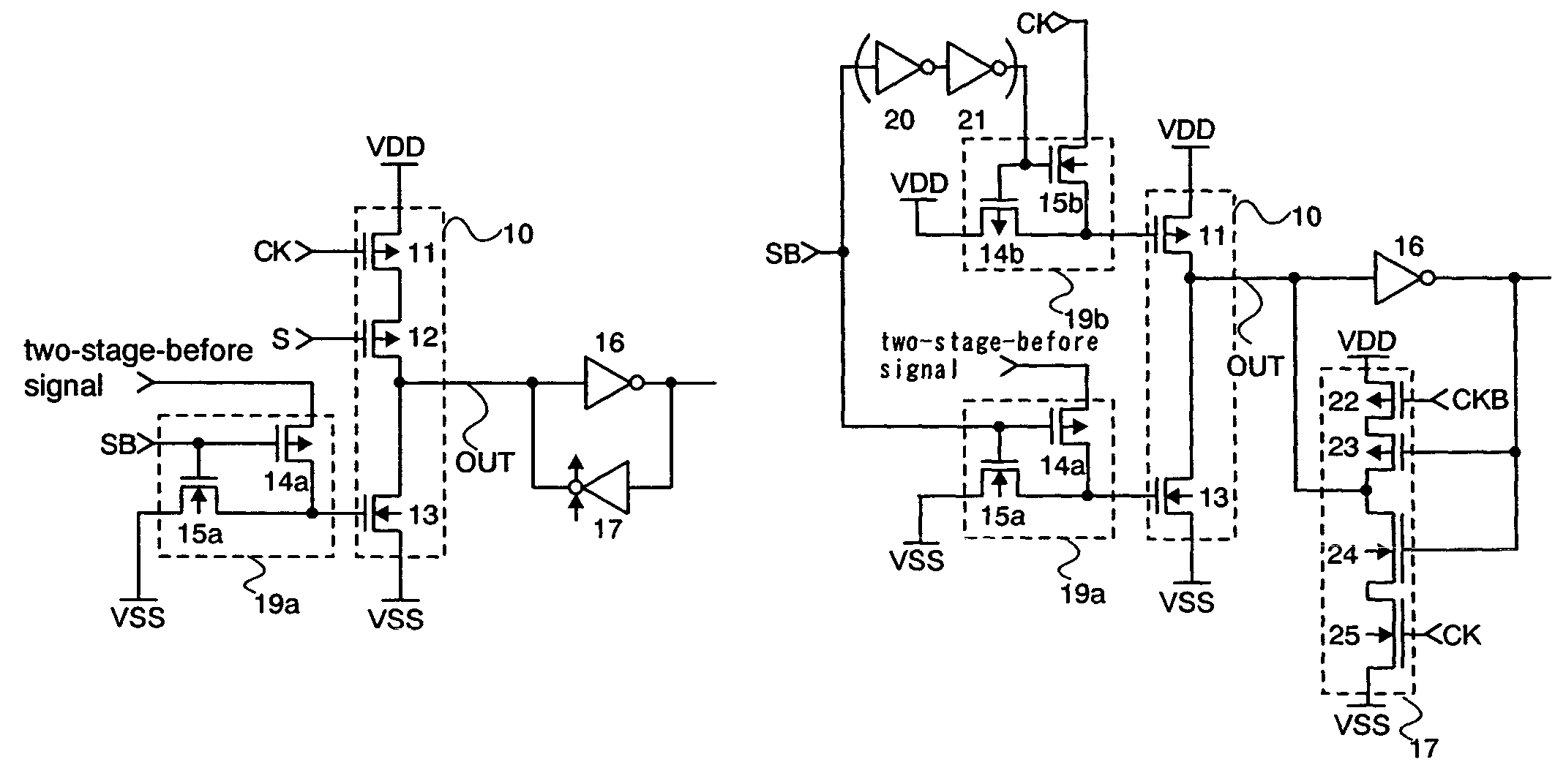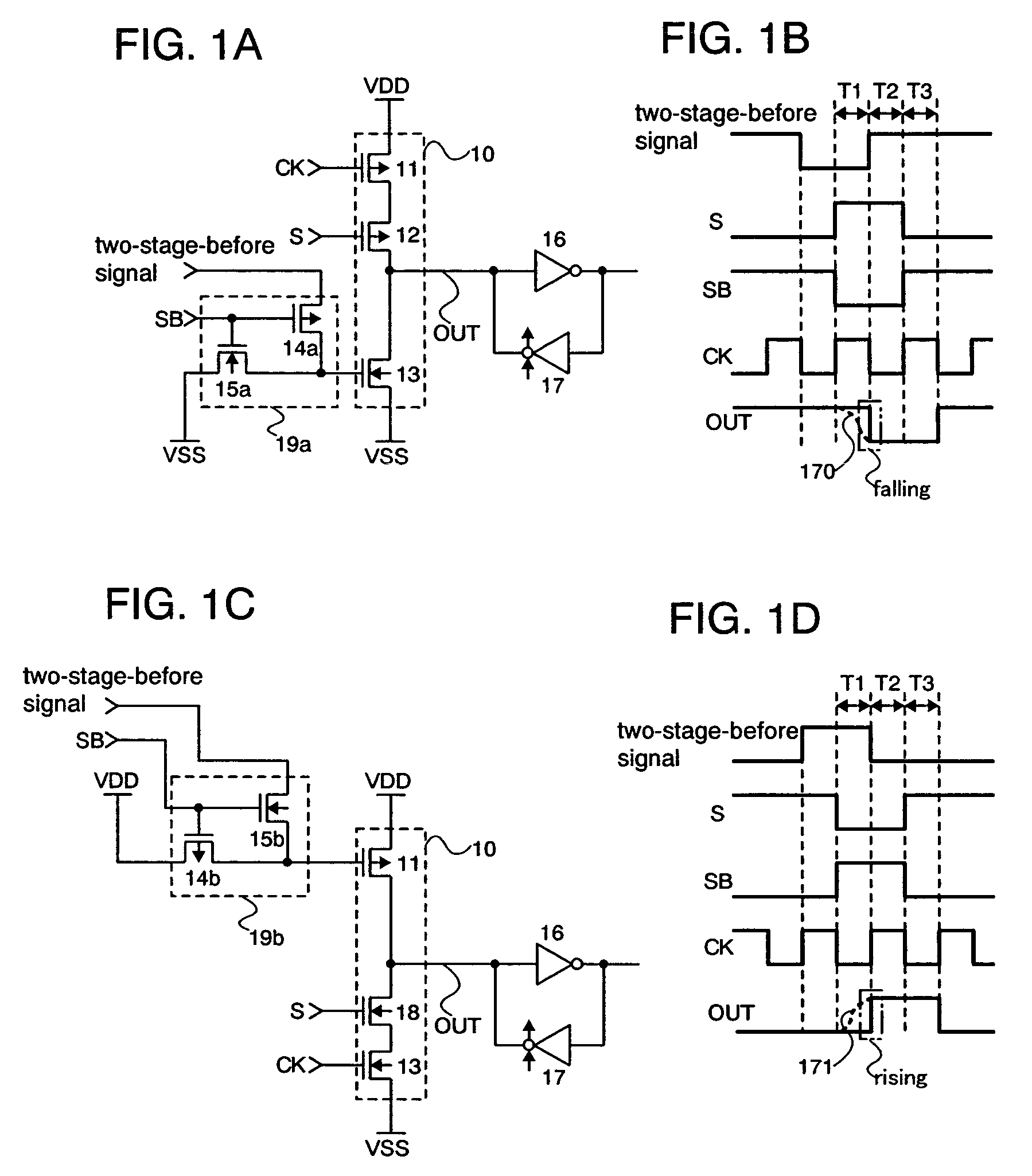Clocked inverter, NAND, NOR and shift register
a technology of shift register and clock inverter, which is applied in the direction of generating/distributing signals, pulse techniques, instruments, etc., can solve the problems of increasing the total size of the device casing, reducing the frequency property, and increasing the occupation area of the driver circuit, so as to reduce the area occupied by the driver circuit, the effect of reducing manufacturing costs and power consumption
- Summary
- Abstract
- Description
- Claims
- Application Information
AI Technical Summary
Benefits of technology
Problems solved by technology
Method used
Image
Examples
embodiment mode 1
[0064]This embodiment mode of the present invention will be described below with reference to FIGS. 1A to 1D. In this embodiment mode, as an example, it is assumed that CK is switched between 5 V (H level) and 2 V (L level), VDD (high potential power source) is 7 V, and VSS (low potential power source) is 0 V. That is, it is assumed that the amplitude of CK is 3 V and a power source voltage amplitude is 7 V.
[0065]A first structure of the present invention will be described with reference to FIG. 1A. FIG. 1A is a circuit diagram showing structural elements of a shift register arranged in the n-th stage. Each stage is formed by a clocked inverter 10 including TFTs 11 to 13 connected in series, a compensation circuit 19a including TFTs 14a and 15a connected in series, an inverter 16, and a clocked inverter 17. The shift register is formed by cascade-connecting the respective stages, in which these circuits are arranged, with signals from CK and CKB being alternately inputted at the res...
embodiment mode 2
[0133]It is possible to use the first to sixth structures described above with reference to FIGS. 1A to 1D, 2A to 2D, and 3A to 3D by freely combining them. In this embodiment mode, an example of the combination will be described with reference to FIGS. 6A and 6B and FIGS. 7A and 7B. Note that in those drawings, a signal S is a start pulse or an output of a clocked inverter 16 arranged at the (n−1)th stage, and a signal SB corresponds to the inverted signal of the signal S. Also, the term “two-stage-before signal” corresponds to the output of the clocked inverter 10 arranged at the (n−2)th stage.
[0134]FIG. 6A is a circuit diagram in which the third structure (see FIG. 2A) and the fifth structure (see FIG. 3A) are combined, and shows structural elements of a shift register arranged at the n-th stage. Each stage is formed by a clocked inverter 10 including TFTs 71 to 73 connected in series, an inverter 16, a clocked inverter 17 including TFTs 74 and 75 connected in series, TFTs 76 and...
embodiment mode 3
[0139]This embodiment mode according to the present invention will be described with reference to FIGS. 10A and 10B.
[0140]FIG. 10A shows a plan layout view (top view) of the circuit diagram shown in FIG. 6B. FIG. 10B shows a photograph of a panel that is actually made, magnified by a light microscope.
[0141]Reference numerals and symbols in FIGS. 10A and 10B correspond to those in FIG. 6B, and thus the description is omitted here. In FIGS. 10A and 10B, a P-type TFT 16a and an N-type TFT 16b constitute an inverter 16, and a P-type TFT 123a and an N-type TFT 123b constitute an analog switch 123.
[0142]The W (gate width) of the TFT 94 is set large. If another TFT that is connected with the TFT 94 in series and has the same size as the TFT 94 is required, the layout area becomes larger. However, only one TFT 94 whose W is set large is required in the present invention, and therefore the expansion of the layout area is suppressed.
PUM
 Login to View More
Login to View More Abstract
Description
Claims
Application Information
 Login to View More
Login to View More - R&D
- Intellectual Property
- Life Sciences
- Materials
- Tech Scout
- Unparalleled Data Quality
- Higher Quality Content
- 60% Fewer Hallucinations
Browse by: Latest US Patents, China's latest patents, Technical Efficacy Thesaurus, Application Domain, Technology Topic, Popular Technical Reports.
© 2025 PatSnap. All rights reserved.Legal|Privacy policy|Modern Slavery Act Transparency Statement|Sitemap|About US| Contact US: help@patsnap.com



